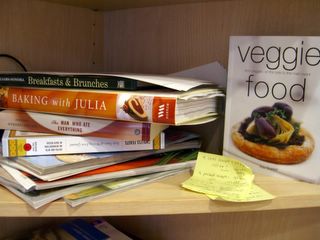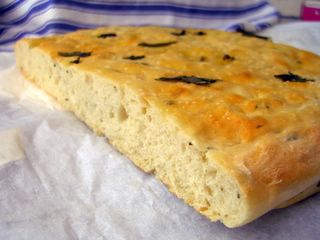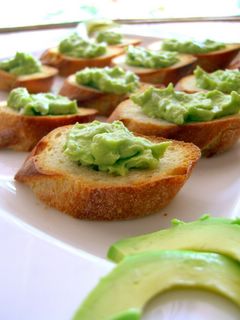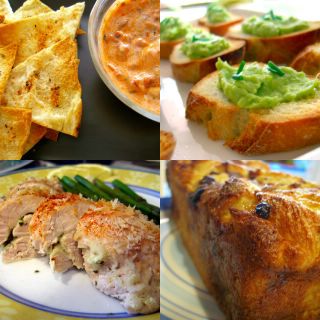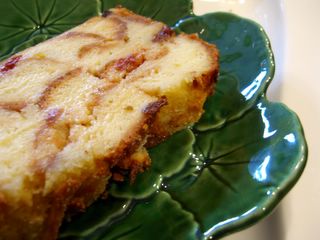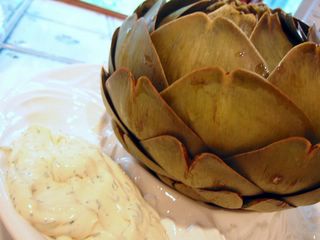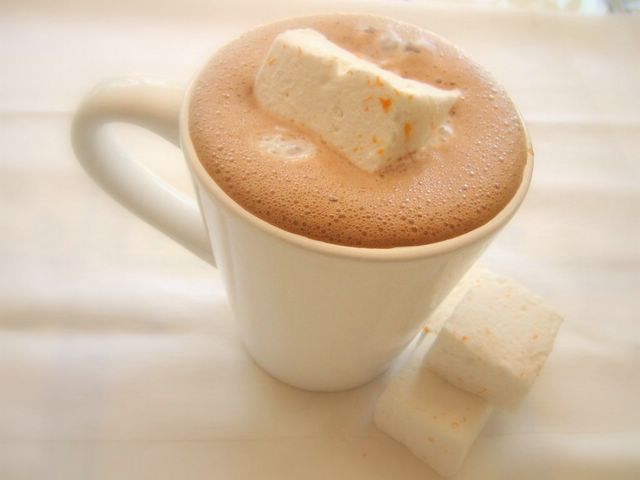Friday, May 27, 2005
The Cookbook Meme
1. Rationale behind what we're seeing?
This shelf is in a semi-hallway and nothing else fit it appropriately. As such, it became the cookbook self. There isn't much order, nor are all my cookbooks on this shelf. But I wasn't about to go hunting them all down for a photo. The top shelf has notebooks of recipe clippings from my mother that I don't think I have ever look in, as well as the tall cookbooks that didn't fit onto the middle shelf. The middle shelf is at eye level and should contain books I look at frequently, but my most frequently used books are often floating around the house and never make it to the shelf. I tend to set books down on the bottom there, along with stacks of cooking magazines. My EatingWell's are in the kitchen, along with a couple other favorites.
I get a lot of inspiration from other bloggers and the internet, too.
2. Most recommended?
The Best Recipe. It offers a ton of insight as to why things work a certain way - I learned a lot for this book.
3. Cookbook that made you what you were?
The thing that inspired me most, in terms of cooking, involved recipes, but was not a cookbook. When I first began watching Sweet Dreams, on the Food Network, I couldn't believe that I had been missing out on so much. Gale Gand made it look easy. And you know what? It is.
4. Porniest cookbook?
Baking with Julia.
5. Sophie's Choice cookbook?
Not making that call unless I have to.
6. If you were a cookbook, which cookbook would you be?
Which would I be or which would I like to be? The Joy of Cooking.
7. If your cookbook were extremely valuable, so valuable you might hide it with other valuables, where would that place be?
Since I seem to spend quite a bit of my money on cookbooks... I'd have to say I'd hide it on the shelf in my hallway!
I have to see what Niki has on her cookbook shelf!
Thursday, May 26, 2005
Cooking School: Puff Pastry, Tarte Tatin and Palmiers
Lots of recipes today! I made puff pastry from scratch. It is far and away the best puff pastry I have ever tasted. I'm modest, I know, but man it's good.
I have, as have many other people, only ever used frozen puff pastry. It is convenient, inexpensive and works very well. I can now proudly say that I have passed the puff pastry trial by fire and joined the ranks of the bloggers who did it before me. To put it briefly, it involves a lot of butter, a lot of folding and a lot of rolling. You also have to keep it cold the whole time.
One of the biggest challenges is to keep the pressure even the whole time you are working with the dough so your edges will stay straight and none of the butter will be able to escape. Several people in class had problems with this and their pastry became gooey as their holes got larger and butter escaped.
To make a good pastry, shape your butter into an even rectangular block before you begin. Mush the block together and refrigerate to keep it firm. This way you will only have one piece of butter to work with and you will not have to worry about individual pieces moving around. Use lots of flour when rolling to prevent the dough from sticking. There is plenty of butter in the pasty, so you will not toughen it by using flour! A few people, since they were not using enough flour, had problems rolling their dough. The best way to roll is use lots of short strokes, which will prevent the butter from being pushed to the side and out of the dough. If you do make a small hole, dab a bit of flour over it so it doesn't stick to the rolling pin and continue on. It will probably get covered during the next fold.
Many instructions state that it is necessary to make 6 turns in your pastry. When you're making it by hand, you should only make 3 or 4 turns. It simply isn't that practical to try so many turns without the consistency of a machine - your odds of tearing your dough or squeezing out the butter really increase. Try for 4 turns and stop at 3 if you seem to be getting a few holes. As long as the butter stays inside your pastry, your dough will still be flaky.
Puff Pastry
2 cups ap flour
2/3 cup cake flour
10 ounces butter, cold (2 1/2 sticks), divided
1 1/4 tsp salt
3/4 - 1 cup cold water
Take 8 ounces of butter (2 sticks) and shape into a block roughly 1/4 inch thick. If you are using stick butter, slice each stick into three long pieces and make a 2x3 block. Press butter together well and refrigerate.
Combine flours and salt in food processor. Pulse lightly to combine. Add remaining 2 ounces (1/2 stick) of butter and cut in until dough looks like sand. With the motor running, add 3/4 cup water. If dough has not come together, add remaining water slowly.
Flatten dough into a smooth disk, wrap and chill for 1 hour.
On a well floured surface, roll dough out into a large (10 inches or so) circle. Set butter block in the center and fold up the extra dough as though you were folding an envelope: fold over the sides, the fold the top down and the bottom up. Turn the seam side down and roll until envelope has quadrupled in size. USe short strokes, keeping the pressure as even as possible, and lots of flour.
Fold the dough in thirds as though you were folding a business letter. This is one turn. Wrap and refrigerate dough for at least one hour and up to two days.
To make turns 2, 3 and 4, place chilled dough seam side down on a well-floured surface and roll out again into a large rectangle. Try to keep the dough as evenly rectangular as possible. Fold as you would a business letter. Wrap and chill.
Dough can be frozen until ready to use.
You can use your puff pastry to make a Tarte Tatin, shown above. Be sure to check your apples with a tester because cooking times may vary depending on the softness of your apple.
Tarte Tatin
1 cup sugar
2 ounces butter (1/2 stick)
6 medium apples
10" square of puff pastry
Preheat your oven to 400F.
Peel your apples and cut them in half, removing cores.
Put sugar into a 9 inch, oven safe skillet. Cook over medium heat until sugar is a deep brown. Stir in butter, then turn off the heat and let caramel rest for 5 minutes.
While caramel is resting, roll out your puff pastry and cut a vent in the center.
Arrange apples in the caramel so that there are no open spaces. Place puff pastry over apples and tuck the edges lightly around the apples.
Bake until golden brown and the apples are soft when poked with a tester, about 25-30 minutes.
These are the best palmiers I have ever eaten. What a difference homemade pastry makes - though ones made with store bought will be almost as good if you buy a high quality dough. Don't put cinnamon in your palmiers. As it was put in class: "French people will roll over in the graves if you do." Even the living ones? Yes, even the living ones.
Palmiers
1 recipe for puff pastry
lots of sugar
Preheat oven to 400F. Line a large baking sheet with parchment paper.
Roll out your puff pastry on a floured surface until it is as thin as you can get it. Cover generously with sugar. Starting at the right side, roll the pastry until it reaches the center. Repeat with the left side.
Cut roll into 1/2 inch segments.
Spread more sugar onto your work surface. Fold each segment into a V shape and press it down into the sugar, flattening it with the palm of your hand. Use lots of sugar. Place each palmier on baking sheet.
Bake 12-15 minutes, possibly a bit more depending on your oven, until golden brown.
Wednesday, May 25, 2005
Butterscotch Chocolate Chunk Blondies
Blondies are a great thing to make when you're visiting someone else's home. They are as simple as baking a batch of cookies, but actually take less time because all the dough goes into the oven at once. You can add anything that is lying around the kitchen, so having anything beyond the basic butter-sugar-flour-egg ingredients is not vital. Chocolate chips, nuts, chopped candy bars, dried fruit or candied fruit will all work. Much like making brownies, there is no need for multiple pans. And, of course, cookies require nothing beyond a bowl and a spoon for mixing.
I visited my brother this weekend and wanted to bake something for him and the guys he lives with. There are 5 of them, in total. Now, these guys do cook for themselves - not haute cuisine, but they know how to use appliances other than the microwave. Cooking is not a priority for them, though, so sometimes specific utensils or equipment that I consider vital are lacking: spatulas, whisks, an actual baking sheet (they use a round pizza pan). I used a 9x13 casserole dish, lined with aluminium foil. I recommend lining the pan instead of greasing it with butter or cooking spray because the blondies will be much easier to remove. They had flour, sugar, butter and eggs, though the brown sugar and the baking soda that I used I bought for them on my last visit. I used chopped up Hershey bars and butterscotch chips, roughly equal amounts of each, but probably a bit more chocolate. Total time took about 30 minutes, not including preheating or mise en place. Easy.
Once baked, the blondies can be cut into any sized bar. So they work as well for a crowd as they do for a small group.
Butterscotch Chocolate Chunk Blondies
2 cups flour
1 tsp baking soda
1/2 tsp salt
1 cup sugar (half brown, half white)
1 cup butter, softened
2 eggs
1 tsp vanilla
1 1/2 cups butterscotch chips/chocolate chunks/whatever is lying around
Preheat oven to 375F. Line a 9x13 inch baking pan with foil or parchment paper.
Stir together flour, baking soda and salt.
Cream butter and sugar by hand or with an electric mixer. Add in eggs one at a time until incorporated. Stir in vanilla.
Add flour mixture to butter mixture in 2 additions, then add your chocolate/butterscotch chips and stir until batter is smooth. Spread evenly into your prepared pan.
Bake 20-25 minutes, until the edges are golden brown (A slightly longer baking time will produce a slightly more cakelike cookie). A tester should come out clean, if you use one.
Let cool in pan for 10 minutes, then lift out onto a rack for further cooling. Cut bars as desired.
Monday, May 23, 2005
Roasted Grapes
As always, I read the reviews first. The feedback from other cooks is usually very helpful. I noted that several of them mentioned that they had to increase the amount of gelatin. I decided to add vanilla paste to the yogurt instead of flavoring it with cardamom. I increased the amount of gelatin without considering that I was also using greek style yogurt, which is much thicker than regular whole milk yogurt. This resulted in a pudding that was tasty, but too firm. Fortunately, I had roasted some grapes to accompany it and their heat caused the pudding to melt a bit. Everything turned out deliciously, even it it wan't the texture I was hoping for. Next time the pudding will turn out better, but I couldn't have hoped for better results on the grapes, which were amazing. Divide the grapes into small bunches - they look gorgeous.
Sunday, May 22, 2005
IMBB #15: Posh Jelly Root Beer Float
While scouting for appealing recipes, I came across a recipe on the Food Network website for Root Beer Gelee and Vanilla Panna Cotta. I love root beer floats and that is what came to my mind immediately when I saw their photo. How could you not love a tall glass of cool root beer poured over a big scoop of vanilla ice cream? I imagined that the combination of panna cotta and root beer would be similar in flavor. It turned out to be a great combination.
Unfortunately, I had no root beer and used vanilla bean cream soda instead, as you cen see in the photo, so this is not actually a root beer float. I really enjoyed this dessert, though, and think that it would have been fantastic with root beer. Root beer has a stronger flavor than cream soda and, though the vanilla melded well with the panna cotta, I think something slightly more assertive would have been more interesting.
It didn't take very long to set the gelatin, but do be careful when pouring in the panna cotta layer. I would advise you to pour it down the side of the glass to avoid putting pressure on the surface of the root beer layer. You can leave it in your fridge for quite some time before serving, but because the panna cotta layer is not so thick, I would suggest letting it soften slightly at room temperature for 10 or 15 minutes before serving.
Friday, May 20, 2005
SHF #8: Very Orange Chocolate Chip Cookies
I have not been baking enough cookies lately. And cookies are one of my favorite things to bake! They travel well and can be subject to endless variations - even within one batch of dough. Even so, for this month's Sugar High Friday, with an end-of-winter citrus theme chosen by Alice, I had to think long and hard before deciding to bake cookies. Part of the reason for this is that, once again, IMBB is hot on the heels of SHF and the two themes kept melding in my brain.
But back to the cookies.
I couldn't quite decide on the cookie recipe I wanted to use. I almost made a ginger-molasses cookie, then the temperature skyrocketed here in LA and I wanted something lighter. I considered making a cardamom cookie. Then I found a bag of chocolate chips just begging to use used. And, of course, I had to incorporate some kind of citrus!
The citrus part was easy, since I have lemon, orange and lime trees in my yard. I decided that orange would go best with the chocolate chips. I threw a bit of everything into the bowl and out came some amazing cookies. When they are fresh from the oven they are crisp on the outside, chewy on the inside and have a great orange flavor. The molasses, cardamom and cinnamon enhance the orange and don't really assert themselves individually, creating a great blend. I don't often use shortening to make cookies, but I had some Earth Balance in the fridge already. In this instance I was really pleased with the way that there wasn't a buttery flavor to compete with the orange.
My dough was a bit crumbly, but very easy to work with. I formed it into balls by hand. This makes a small batch because I didn't want to be tempted by so many cookies - good thing, too, as I ate almost half straight out of the oven! You can easily double the recipe, though.
Very Orange Chocolate Chip cookies
1 cup flour
½ tsp baking soda
½ tsp baking powder
¼ tsp cardamom
¼ tsp cinnamon
¼ cup shortening
¾ cup turbinado sugar
1 tbsp molasses
½ tsp vanilla
1 tbsp orange zest
1 egg
1/4 cup chocolate chips
Preheat oven to 350F.
Whisk together flour, baking soda, baking powder, salt, cardamom and cinnamon.
Cream together shortening and sugar. Add in molasses, vanilla orange zest and egg. Beat until well combined and light.
Add flour mixture to egg mixture and stir until just combined. Add chocolate chips.
Form cookies into tablespoon sized balls. Flatten before baking for a crisper cookie, or leave as a ball for a puffier cookie.
Bake, in a preheated oven, at 350F for 11-12 minutes, until very slightly browned at the edges.
Let rest on cookie sheet for 1-2 minutes before transferring to a wire cooling rack.
Makes 1½ dozen
Thursday, May 19, 2005
Cooking School: Brioche
We started out brioche dough last week and left it in the freezer. Brioche is a very enriched french pastry dough - the french pastry dough, in fact. I discovered that I thought I had had brioche, but I was wrong. It seems that many bakeries, at least here in the US, simply pass off their challah breads as brioche. In reality, brioche has more of a pound cake texture than challah and involves about twice the amount of eggs and butter (though oil can be used in challah instead of butter). The dough is also very unusual in that you cannot overwork it. I mean, it is possible, but that would take an extremely long time. This is also not a bread I would recommend making without a stand mixer.
What you need to do is mix the yeast, liquids, eggs and flour until shiny and silky, which will take anywhere from 10-15 minutes. Add the butter in gradually and beat until fully incorporated, which will take an additional 10- 15 mintes in your mixer. The dough will look very strange and stringy, like spiderwebs. It will feel very sticky and will be able to stretch out quite a lot if you pull it. Let the dough rise - no need to grease the bowl because of the amount of butter in the dough - overnight in the refrigerator. This is crucial as you want the air bubbles to develop slowly. You must slow rise brioche! Also, it's easy. Let the dough come to room temperature, shape it and let it rise a bit before baking.
Brioche is so rich, as a bread, that it should be baked at a fairly low temperature (350F) to prevent scorching.
Brioche
8 ounces butter, slightly softened
1/2 cup warm water
1 tbsp active dry yeast
5 eggs
16 ounces flour
2 ounces sugar
1/2 tsp salt
Dissolve yeast in warm water and let stand for 5 minutes, until foamy. Beat eggs lightly with a fork and set aside.
Place flour, sugar and salt in the bowl of an electrice mixer. Mix briefly to inforporate. Add yeast mixture to flour, along with approximately 2 eggs. Mix until the dough resembles pie dough, then slowly add more egg. Once all the egg has been incorporated, continue to run mixer until dough is shiny, smooth and wet. It will cling to the sides of the bowl in ribbons. This will take 7-10 minutes. Cut the butter into 1-2 tablespoon chunks and add to dough. Mix until butter is completely incorporated. Dough will be very stringy and elastic when mixing is complete. Place into a large bowl (unoiled), cover with plastic wrap and let the dough begin to proof for 1 hour. Place bowl in the refrigerator for 12-24 hours. This dough must slow rise.
Remove chilled dough and let it come to room temperature before shaping and baking. After shaping, let dough rise a second time and glaze with an egg white to produce a nice shine. Muffin sized brioches, similar to the ones shown above, will take about 20 minutes in a 350F oven.
We made both traditional brioche and pain au raisin with our brioche dough.
For pain au raisin: roll out the brioche dough, spread it with vanilla pastry cream and sprinkle it with a healthy portion of rum-soaked raisins. Roll it up like a jelly roll, slice into 1 inch rounds and let proof until doubled on a baking sheet. Bake at 350F for 20-25 minutes, until golden.
Wednesday, May 18, 2005
Healthy Cornbread Muffins
I will say that the flavor and texture were very good (particularly with chili, butter and honey!) so I will be making this again. It definately was a good accompaniment for my chili. When the flavor and texture are good I have to assume that it was error on my part, not necessarily the part of my recipe. As such, I'll post it here. Just remember: good flavor, but watch for overbaking!
If you're not watching the calories, you'll get a moister muffin if you use 1/4 cup oil instead of the 1/4 cup yogurt + 1 tbsp oil called for below.
Tuesday, May 17, 2005
Rosemary Olive Bread
My neighbors were the recipients of about half of this loaf and they reported that it makes excellent toast. And with EoMEoTE coming up, it doesn't take a genius (or a gourmand) to see the possible applications of a good toasting bread.
Did I mention that this bread is a snap to put together? These instructions direct you to mix by hand, but you can also do it in a mixer with a dough hook.
Rosemary Olive Bread
3 cups bread flour (ap will work fine, too)
1 tbsp sugar
1 tbsp salt
3/4 cup warm water
1 tbsp active dry yeast
1/4 cup olive oil
1 1/2 tbsp coarsely chopped fresh rosemary
1/2-1 cup Kalamata olives, pitted and coarsley chopped
Combine yeast and warm water until yeast becomes creamy, about 10 minutes.
Add olive oil, salt, sugar, rosemary and olives into the yeast mixture and add flour 1/2 cup at a time, mixing until dough comes away from the side of the bowl. Move dough to a lightly floured surface and knead for about 5 minutes, until dough is smooth and elastic.
Place dough in a lightly greased bowl, turn to coat, cover with plastic wrap and leave to rise until doubled in size, about 1 hour.
Preheat oven to 400F.
Shape dough gently into a ball. Place on a baking sheet and let rise, covered with a damp towel, for 30 minutes. Dust the bread ligtly with flour, slash the top and put into the oven.
Bake for 35-45 minutes, until bottom sounds hollow when tapped.
Place on a wire rack to cool.
Monday, May 16, 2005
Memories in a Bowl
One thing that the kitchen did really, really well was roasted pumpkin. Sometimes it was roasted butternut squash, but it was always delicious. The best part was that the next day, at lunch, we would get the leftovers as soup. It was just leftover pumpkin, water, salt and pepper, with perhaps a dash of nutmeg, pureed and served with sour cream and toast soldiers. It was my favorite, so I made a quick batch and pretended that I was back in Aus. Thankfully, I didn't have to endure an awful jelly trifle for dessert!
Friday, May 13, 2005
Sage Focaccia
I mentioned that yesterday, in class, we made focaccia in addition to our tortillas. I'm fairly certain that I had never before had sage focaccia. Now I am not sure that I want focaccia without it. The flavor was subtle and the taste was fabulous. This was a soft, light bread that I turned into some great grilled sandwiches for dinner.
Focaccia is a yeasted, flat italian bread that is brushed (or doused) with oil before it is baked until golden. Unlike many breads, this bread is intended to develop a soft, thin crust. The best way to do this is to bake it on a sheet pan and allow it to cool on the pan before removing it to a rack. When you lift the bread, you will notice that the bottom of the pan is wet from condensation; the bread will dry on the rack, preventing sogginess, but this condensation keeps the crust from becoming hard, crispy or dry. I wish I had thought to take a photo of the lovely, dimpled bottom of the bread. But make it yourself and see what I mean.
This recipe makes a big batch - one 11x15 inch rectangle or 3 9-inch circles. You might want to halve it. You could also use rosemary instead of the sage if sage is unavailable to you. Wrap it in plastic wrap when completely cooled to keep it soft.
Sage Focaccia
4 tsp active dry yeast
1/4 cup warm (110F) water
2 1/2 cups room temperature water
2 tbsp olive oil
6-7 cups ap flour
1 tbsp salt
24-30 chopped fresh sage leaves, plus extra whole leaves for garnish
1/4 - 1/2 cup olive oil
salt (coarse or flake is preferable)
24-30 chopped fresh sage leaves
Combine yeast and warm water in a large bowl and leave until yeast is foamy, about 10 minutes.
Stir 2 1/2 cups water, 2 tbsp olive oil, 2 cups flour and 1 tbsp salt into the yeast mixture. Add in the remaining flour, one cup at a time, until dough comes away from the sides of the bowl into a ball. Add the sage halfway through the flour additions. Move dough to flat surface and knead dough for 5-8 minutes, until the ball is smooth and elastic. Place in an oiled bowl, covered with plastic wrap, until doubled - about 1 1/2 hours.
For a rectangular focaccia: Gently lift the dough onto an oiled 11x16 jelly-roll pan(or cut in half and use two smaller baking sheets with sides), stretching it out slightly as you transfer it.
For a round focaccia: Cut the dough in three pieces and gently lift the dough into three oiled pie pans.
Splay your fingers and press into dough, indenting it and pushing it out towards the sides of the pan, much like a cat kneading a blanket, until the pan is full. This keeps the air bubbles in the dough. Cover with a damp towel and let rise for 30 minutes.
Preheat oven to 400F.
Dimple dough again with your fingertips, brush with 1/4-1/2 cup olive oil, sprinkle liberally with salt and garnish with sage leaves. Let dough rest until the oven is fully preheated.
Bake for 25-30 minutes, until bread is golden brown. Let cool in pan for 20-25 minutes before removing it to a wire rack to cool completely.
Thursday, May 12, 2005
Cooking School: Flatbreads and Tortillas
At first I did not believe that it is impossible to make a great pizza in a conventional oven on a baking sheet. After all, I have made pizzas this way many times. Our instructor mentioned today that if your oven is hot enough to produce an excellent crust, the toppings will be burnt long before the crust is done. Therefore, you must use a baking stone, which is itself hot since it is kept in the oven, to properly cook your pizza.
I scoffed. My pizzas were just fine, thank you very much.
Then I tasted the pizza we assembled in class.
I do not, unfortunately, own a baking stone, so it looks like I'll be holding off on pizza for a while.
Sure, it had homemade sauce and ultra-fresh mozzarella, but the crust made the pizza. Mine was very thin and wonderfully, wonderfully crisp. Of course, I was only able to eat half of mine. I left to get a second helping of the roasted asparagus and was slightly dismayed to discover that the muncher seemed to have absconded with my leftovers while her pizza was still in the oven - Her significantly less than perfect looking pizza, as she refused to wait until the ovens were free before loading her dough onto the peel. Since no one could get their pizza out of the very hot oven without the peel, her pizza (toppings and all) had to be unloaded and reloaded. Ah well. There were other things to eat.
We also made sage focaccia (mmm!) and authentic flour tortillas. I use the word authentic because we made them with lard. Before you gasp in shock and, possibly, disgust, let me say a few things about lard. First of all, it has roughly the same fat and calorie count as butter and oil - slightly less than oil, actually - and falls in between the two with the amount of saturated fat it contains. It produces flavorful baked goods due to its every so slight salty/meaty taste and contributes to a very tender product, as well. Tortillas are not exactly tender, but their fillings are well complimented by using lard. The lard is a soft solid at room temperature and makes the dough incredibly easy to work with and roll out. I didn't need to add any extra flour because the rolled dough didn't stick to my work surface at all.
Use shortening if you can't find lard.
And don't worry, I'm posting about the focaccia tomorrow.
Tuesday, May 10, 2005
Overripe Banana Souffles
Fortunately, I learned an easy way to use up a few bananas when I took a class a while back (not affiliated with my baking class). The class, if you'll recall, was about making souffles. The instructor named this as a low fat souffle, but I think she included it to reinforce just how easy it is to make a souffle.
For these, a mashed up banana provides the majority of the base - no cooking necessary! It is thickened with a bit of cornstarch, flavoring is added and then egg whites beaten with sugar are folded in. The whole process takes less than 5 minutes, including the time to grease and sugar your ramekins. The taste is light and airy, with a nice banana-y richness. Once you've made the basic recipe, you can easily add other flavors or spices for variety. In the photo above, you can see ginger (with crystalised ginger), molasses and buttermilk, honey and chocolate (with mini chocolate chips) banana souffles.
The chocolate souffles are very chocolatey. I make these often because they're so easy and light. And because I have bananas. Lots of them.
Monday, May 09, 2005
Blogging Inspired Mother's Day Dinner
Everyone knows that you are, if possible, obliged to provide some sort of meal for you mom on mother's day. Flowers are an acceptable substitute, but taking her out to brunch or cooking her dinner is ideal. This, apparently, is supposed to compensate/show appreciation for all those years that she slaved over a hot stove cooking meals that you may or may not have appreciated when you were growing up.
I cooked dinner.
I was inspired by several bloggers. I started with pita chips with a roasted red pepper and yogurt dip. The next dish was almost Johanna's Avocado and Goat Cheese crostini. I rubbed garlic and a drizzle of olive oil on sliced baguettes, used mascarpone instead of goat cheese and topped each slice off with a sprinkle of chives and Maldon sea salt. I loved Caryn's Chicken Roulades, but, once again, switched out the goat cheese. I blended feta cheese, basil and a bit of lemon juice and spread it onto the chicken before rolling it up. I sprinkled paprika and bread crumbs on top of the roulades before baking them at 375 for about 40 minutes. The cheese kept the chicken very moist. I served the chicken with a side of roasted asparagus. This was all finished up with coffee and my bread pudding.
Everything was well recieved. And now I can cross a few things off my "to-do" list.
Sunday, May 08, 2005
Restaurant Style Bread Pudding
So, I baked this loaf-style bread pudding for Mother's Day because my mom loves custardy desserts. I used challah and slightly lightened the original recipe, which used heavy cream and whole milk while I used half-and-half (half cream, half milk) and low fat milk. Bread pudding is a great way to use up bread that is getting stale. Or cream that you have lying around.
This recipe makes a dense and custardy pudding that is just sweet enough. It's not too heavy because the eggs provide just enough lightness. Use enough bread to completely fill your loaf pan. You can use any type of dried fruit. I think that dried cherries pair really well with vanilla and I added some currants for variety. If you're going to soak your fruit in brandy, as I did, as little as 30 minutes will work.
Preheat oven to 375F. Grease a 9x5 inch loaf pan well, but do not flour it.
Friday, May 06, 2005
Spring Side Salad
Blanched grean beans, fresh sweet corn (or frozen), sliced red onions and halved plum tomatoes, dressed with a drizzle of vinagrette and a good sprinkle of salt and pepper. It's the perfect side to anything that comes off your grill this summer.
Thursday, May 05, 2005
Cooking School: Challah and Yeasted Breads

Ah, bread! The class I've been looking forward to all session! True - I have been looking forward to all the classes, but I am always looking to improve my bread baking skills.
We started off by talking about yeast. Freeze dried yeast and cake yeast are the two types of yeast most commonly available to home bakers. Cake yeast is preferred by bakers because it is much easier to weigh it out when they're scaling recipes. If you work at a specialty bakery, or bake a lot of bread, you are probably familiar with the third yeast type: wild/organic yeast. Wild yeast is a rather stupid beast and, though it's sort of a pain to feed it all the time, you will only need water, sugar and flour to catch some. You also need a relatively warm - above 50F - climate, or all the wild yeast will be hibernating. You cannot catch yeast outside in winter in New York. If you're interested in natural starters, Adam has an extensive set of posts about it, so I won't go into that right now. Let's just say that your best bet, in terms of freshness and shelflife (since it'll last almost forever) is freeze dried yeast. To discern a flavor difference between two otherwise perfectly made loves of bread, one with cake yeast and one with dried, you would have to be a real expert.
Since we had to make three loaves of bread during class, we used active dry yeast for all our recipes. For once, we appreciated how hot is gets in the kitchen because our bread proofed quickly! We made a rustic country loaf, that required a sponge, an olive-rosemary loaf, which I froze to bake at a later date, and challah.
This challah recipe is our instructor's favorite. It has oil, eggs and sugar without going over the top into brioche-level richness. I had never made challah before and found it to be a very easy dough to work with. A woman who was auditing our class for the day told me that she is currently working as a private chef for a Jewish family and that her challah secret is to sprinkle the baking sheet with cinnamon before you place the braided loaf on it. This gives the challah a particularly wonderful aroma without making it taste like cinnamon. Be sure to grease the baking sheet well if you're using the cinnamon trick, as it will cause the loaf to stick slightly.
Challah
1 tsp sugar
1/2 cup warm (110F) water
1 tbsp active dry yeast
1/2 cup oil
1/2 cup warm water
1/4 cup sugar
2 tsp salt
2 eggs
3 3/4 cups flour (and up to 1/4 cup extra for kneading)
1 egg yolk, beaten with 1 tsp water
2 tsp cinnamon (optional)
Dissolve sugar and yeast in 1/2 cup warm water in a large mixing bowl. Let stand 10 minutes.
Add oil, water sugar, salt , eggs and 2 cups of flour to the yeast mixture. Mix unitl smooth, then gradually add remainin flour until dough comes together into a ball and no longer sticks to the sides of the bowl. Let dough rest for 10 minutes. Sprinkle reserved flour onto a smooth surface and knead for 8-10 minutes, incorporating any of the reserved flour as needed.
Place dough into a lightly oiled bowl, cover it with plastic wrap and let rise until doubled, 1-1 1/2 hours.
Oil a baking sheet and sprinkle with cinnamon, if desired.
When doubled, flour your hands and gently remove dough from bowl onto a lightly floured countertop. Cut dough into three even sections and gently stretch them out. Starting in the middle, braid them together. Tuck the ends underneath the dough. Set loaf on baking sheet. Brush very lightly with egg wash, you won't need all of it. Preheat oven to 400F and let dough rise, covered loosely, for an additional hour, until almost doubled.
Bake at 400F for 30 minutes, until deep golden brown.
Tuesday, May 03, 2005
Pasta with Broccoli, Arugula and Tomatoes
Arugula is a bitter green, also know as "aromatic" by people who find bitter to be too negative a word. It has a peppery flavor that kicks in a few seconds after you begin to chew on it. It wilts like spinach, so it can be used in many of the same applications, like pasta dishes and salads. I had a nice bit of broccoli in my fridge that I wanted to use and some arugula seemed like a good accent to a broccoli-pasta dish.
This was a fun dish, with the unusual pasta shape and bright flavors of all the ingredients. The only change I would make would be to add the cheese a bit earlier, as noted in the recipe below, to give it a change to melt slightly into the sauce. It was a good combo and incredibly simple to make. Who doesn't love that in a weeknight dinner? This recipe is also flexible, so if you prefer a more veggie-heavy dish, simply increase the amount of broccoli and reduce the pasta a bit. Vice versa, if you decide you are having a grving for the pasta itself
Monday, May 02, 2005
Another Artichoke Post
In a posting a few days ago, I mentioned my love of artichokes. Thus, I could not resist posting about these "European Style" artichokes I bought the other day. They are easily the largest artichokes I have even seen, let alone eaten.
And I ate them with my standby artichoke dip, shown to me by my mother. Kraft/Hellmans is my preferred brand, but you can use any brand or fat content (regular, light or fat free) you desire and it will still taste good.
Please note that the chef's knife in the following photo has a 7 inch/18 cm blade. And the diameter of the artichoke is the same!
Sunday, May 01, 2005
And now we wait...
I made something I called "Almond Rice Pudding Babycakes", which are essentially rice puddings baked in muffin tins. Cute, eh? Winners will be chosen by June 15th. Wish me luck.


